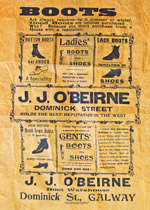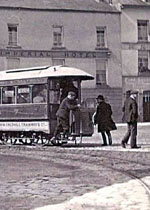Old Galway
Cobblers And Shoemakers (19 03 2015)

The 1651 map of Galway shows a Shoemakers Tower located in what is the Eyre Square Shopping Centre today. Shoemaker’s Lane or Bóithrín na Sudairí, the road of the shoemakers or the tanners was where Buttermilk Walk is today. Shoemaking was always an important business but the individual shoemaker is a rare breed now, instead you associate the craft with factories like Dubarry in Ballinasloe.
The Head of the River (12 03 2015)

In 1976, a group of like-minded people got together to work out a way to make the sport of rowing in Galway more competitive. They decided the best way to achieve this was to set up a new club and so, Tribesmen Rowing Club was formed. Starting a new rowing club is an expensive business so they began a number of fundraising activities, running raffles, organising dances etc. They managed to get their first crew on the water in 1977.
Remembering Máire Stafford (05 03 2015)

Máire and Seán Stafford were a touchstsone of Irish Language Culture in this city for over 60 years . They each had many and different talents and when they were together, they made a formidable team. They were always together. It took him a whole three weeks after he met her to ask him to marry him. They kept Connradh na Gaeilge going for years, they kept Feis Ceoil an Iarthar going for years, they kept Féile Drámaíochta na Scoil going for years, they were the mainstay of An Taidhbhearc from 1950 for many years, their contribution to the quality of life in Galway was immense. They also reared a very talented family, many of whom were on the stage for the first time while still in their mother’s womb.
The Winter Tram (26 02 2015)

This photograph of a single-deck horse drawn tram was taken in Eyre Square c1900. The American style dome roof top cover provided cover for passengers during the winter. In one of their books, Somerville and Ross described these vehicles thus: ‘The little one-horse trams glide along the shining desolate road like white-backed beetles’. This tram was painted in a battleship grey colour. The double-deck open summer trams, which needed two horses to pull them, were painted in olive-green and white.
Post Office Communications (19 02 2015)

This photograph of a group of postmen was taken on December 17th 1928 outside the General Post Office in Eglinton St. The Sorting Office was inside the double gate as was the long narrow passage that brought one into the back of the Post Office. The car in the background was a Model T. Notice the cobbled footpath.
The Galway General Omnibus Company (12 02 2015)

Our photograph today shows a Karrier double-decker bus which was operated by the Galway General Omnibus Company. It was taken at the Spring Show in the RDS in 1924, before it went into revenue earning service. The side panel carries the name of the company, but not the crest. The small lettering on the chassis below the word ‘Galway’ reads ’12 m.p.h.’ A major problem with this type of vehicle was its chain drive which frequently slipped off and caused breakdowns. The bus had solid-tyred wheels and was uncomfortable to ride in.
Memories of Shantalla Place (05 02 2015)

Shantalla Place was a little development of 23 houses which were built by a man named Birmingham, nos. 1 – 6 are on the Rahoon Road, nos. 7 – 23 form a terrace just off that road. Originally, it was called Birmingham Terrace, later Sycamore Drive before they finally settled on Shantalla Place. Mothers on this terrace used to warn their children not ‘to go down to the scheme’ when the rest of Shantalla was being built.
William Street West C.1978 (29 01 2015)

William of Orange had a major impact on the history of this city, so I presume it was after him that three streets in Galway were named after him, Williamsgate Street, William Street and the one in our photograph, William Street West.
.png)